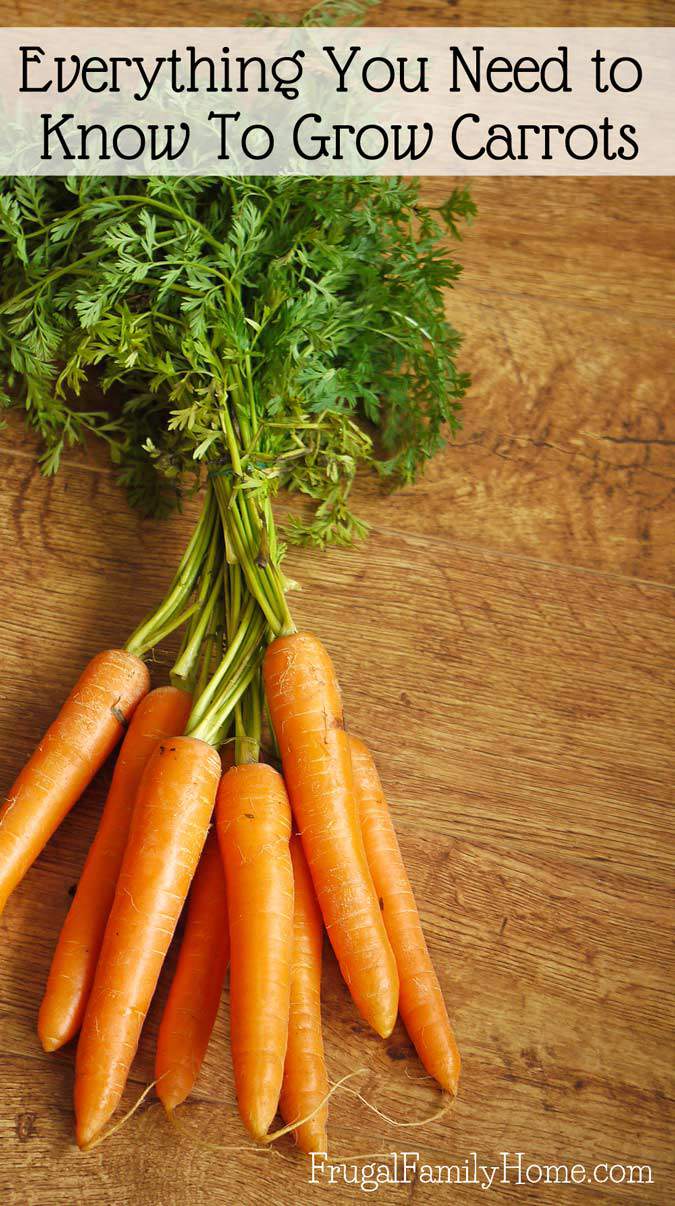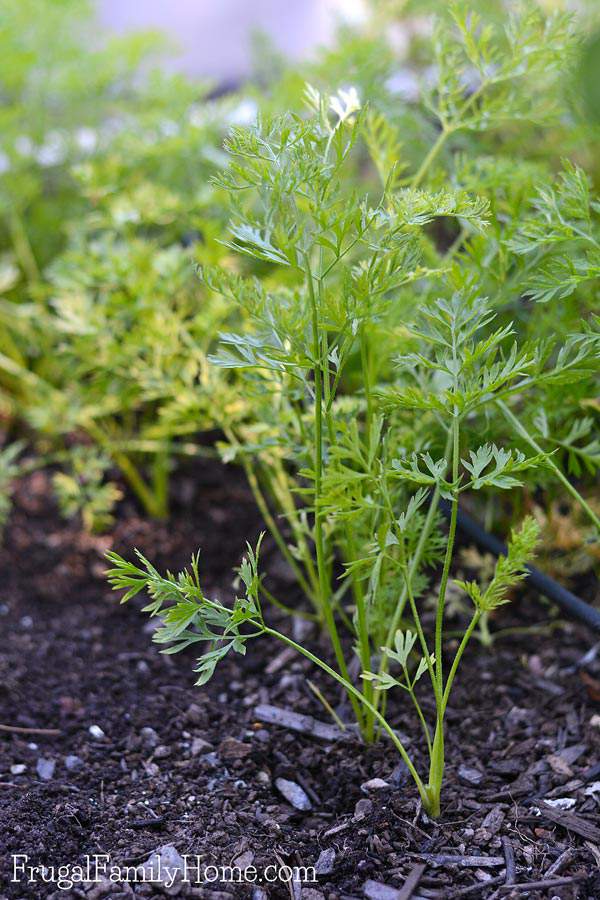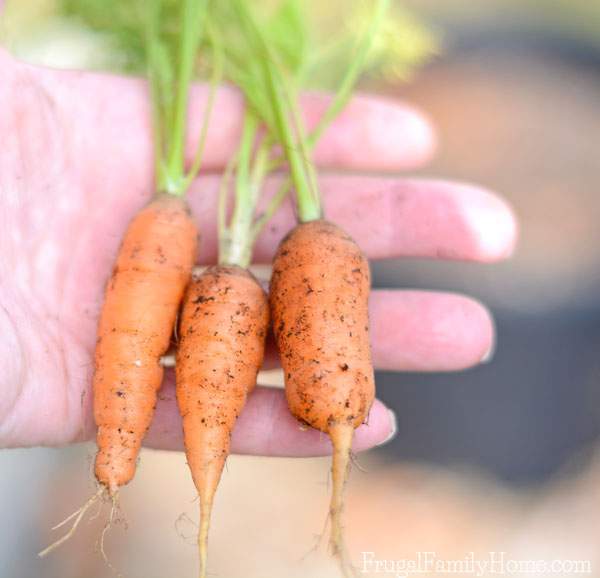How to Grow Carrots, A Backyard Gardening Guide
Carrots are my favorite vegetable of all. You can grow them in pretty much any zone, you just need to adjust your planting time to your climate. There are lots of varieties and colors of carrots too. I’ve put together this gardening guide to give you tips on how to grow carrots in your own backyard garden.

Some of the links below are my referral links. Which means as an Amazon Associate I earn from qualifying purchases and when you purchase through them I can make a little money at no extra cost to you. Thanks! See my disclosure policy for more information.
How to Grow Carrots
Carrots come in a variety of colors. There are the traditional orange carrots, but you can also grow purple carrots, crimson carrots, white carrots, and even yellow carrots. There are also different types of carrots to grow.
There are the ball-type carrots and the longer slender type carrots. The ball-type carrots are the Chantenay, Miniature, or Danvers. These type of carrots can handle heavy clay soils. The long slender type carrots are the Nantes and Imperator. These need loose sandy soil to thrive.
Be sure to pick the right type of carrot to grow for your soil type.
We have heavy clay soil so I usually grow Danvers but I have had pretty good luck with Scarlet Nantes too.
Best Location for Carrots, Picking the Perfect Spot to Grow
You can plant carrots in the ground, in raised beds, or even in containers. If you are limited on garden space then growing carrots in a container might be a good option. Plus it also ensures you can grow them where they can get enough light.
Carrots need 6-8 hours of sunlight each day to grow well. Be sure to plant them in an area of the garden where they won’t be shadowed by faster-growing plants.
Planting Carrots, Get Them Off to a Good Start

Carrots can be planted in the spring or summer. When planting in the spring it’s best to sow them 2-5 weeks before the last frost. For summer planting, plant carrot seeds 10-12 weeks before the first frost of the season. Soil temperatures should be around 50 degrees.
Be sure to prepare the soil before planting carrots. The soil needs to be loose soil at least 12 inches deep. It’s good to add compost and worm casting to the soil before planting.
Carrot seeds can be broadcast planted or planted in rows. Since the seeds are so small a salt and pepper shaker is a good tool to use to sprinkle out the seeds. They need to be planted about 1/4 inch deep.
To make it easier to get the right depth, scatter the seeds on the soil and then cover them with potting mix, compost, sand, or vermiculite.
Some gardeners like to mark where their carrots are planted with radish seeds. If you plant a few radish seeds with the carrots they will emerge to mark the area. This is helpful because the carrot seeds can take longer to germinate.
If you are square foot gardening you can plant 16 carrots per one square foot. I like to plant more seeds and then thin later. To thin carrots be sure to snip the tops instead of pulling them. If you pull them it could damage the other roots nearby.
Keep the soil moist for at least 10 days. Carrot seeds take longer than most seeds to germinate. Be sure to keep the soil moist during germination.
To help keep the soil moist and speed up germination you can cover the planting area with clear plastic. It helps to warm the soil, helps to control moisture, and prevents soil crusting which can inhibit the seedlings from emerging.
Growing Carrots Tips

To grow well carrots need cool soil, good spacing, and proper sunlight. Be sure to keep the soil evenly moist. Also, be sure to plant carrots in an area that gets 6-8 hours of sunlight a day. They can tolerate a little shade but do best in full sun.
By adding compost and worm casting before planting, the carrots have a good source of nutrients. You can add fertilizer but be sure to avoid nitrogen heavy fertilizer. Stick with fertilizer heavier in phosphorus and potassium. Fertilize about 5-6 weeks after planting. Carrots like soil that is between 5.8-7.0 ph.
Carrots need a little room to grow. If the carrots are planted too closely together you can end up with misshapen carrots. Space the carrots 1-2 inches apart until they are about 1/2 inch in diameter. Then thin to 3 inches apart. But don’t throw away those thinned carrots use them in cooking.
Carrots need a steady supply of water. Keep the soil evenly moist. Using soaker hoses or drip irrigation to water is a good way to keep carrots evenly watered. Carrots require about 1.5 inches of water a week.
If the soil becomes completely dry be sure to remoisten it gradually. Water a little over several days to re-establish moisture in the soil. Too rapid of rehydration and the carrots could split.
Keep the carrot area weed free. To keep weeds down around the carrots you can lay newspaper down and cover the newspaper with mulch between rows of carrots. Weed by hand to avoid damaging the carrots or snip the weeds instead of pulling them.
As carrots grow the tops to the carrot might start to stick out of the soil. Be sure to mulch around the tops of the carrot to prevent greening. When the top of the carrot turns green it becomes bitter.
But only the green part will become bitter the rest will be perfectly fine to eat. But to avoid the greening of the carrot top be sure to mulch around them.
Harvesting Carrots

Most varieties of carrots are ready to harvest between 70-80 days. But you can harvest carrots really at any time they are big enough to eat. Although they do get sweeter as they mature.
I often let some of my carrots stay in the ground during the winter and harvest them as needed, as long as the ground isn’t frozen. We have mild winters here so it’s usually not a problem.
When harvesting carrots you can make them easier to pull by watering before harvesting. It’s also a good idea to go alongside the row with a digging fork and loosen the dirt to make the carrots easier to harvest.
Saving Carrot Seeds

I discovered how to save seeds from carrots by accident one year. I left carrots to winter over and I thought I had harvested all of them. In the spring I found I had missed a few. Those few carrots regrew and produced flowers. You see carrots need to grow two years before they produce seeds.
They produce these lovely white flower heads. I let them mature and when the flower turns to a seed head I harvest the seeds. Because the seeds are so small it can be hard to collect them without them blowing all over the garden.
The easiest way I’ve found to collect the seeds is to place the seed head into a zipper topped bag and rub the seed head. The seeds fall out into the bag and not all over the garden. I know when I’ve collected 1-2 seed heads in the past I’ve been set for a couple of years for seeds.
This year I let some of my carrots that wintered over go to seed since I’m getting low on carrot seeds. The flower heads are like big white puff balls and the bees do love them. I love it when I can attract more bees to the garden.
Enjoying Carrots and My Favorite Way to Preserve Them
I’ve found that homegrown carrots are so much more flavorful and fragrant than store-bought carrots. We enjoy them washed, peeled, and cut into carrot sticks. They are a great addition to salads and soups too. But you can also roast carrots.
Roasted carrots have such a great flavor. I cut the carrots in 1 inch long lengths and toss them in a little oil. Spread them onto a cookie sheet and roast in the oven at 400 degrees until they are browned on the edges and soften a little. They have a nice sweet slightly nutty flavor to them.
There are a few ways to preserve your carrots from the garden. You could just leave them in the ground like I mentioned earlier and harvest them as they are needed.
Carrots can be canned. Because carrots are a low acid food you’ll need to pressure can them. If you are new to food preserving be sure to pick up a copy of the Ball Blue Book of Preserving. It has so much great information on pressure canning and other types of food preservation too.
Freezing carrots is another good option for preserving them. To freeze them you’ll want to first blanch the carrots. Blanch cut carrots for about 3 minutes and whole carrots for 5 minutes. Cool in a cold water bath. Then drain and package in freezer bags, can or freeze jars or vacuum pack. Then store in the freezer to ready to use.
But my favorite way to preserve carrots is by dehydrating them. I like this method because it takes up less storage space which can be a premium in our home. If you are looking for a dehydrator, I love mine. I’ve had it for about 5 years now and it works great.
I like that I can prep the carrots to be dried at the same time I’m working on carrots to freeze since the prep work is the same.
I’ve found I can use carrots in most of the winter dishes I make. Dishes like soups, stews, or casseroles. Which are all perfect dishes that work with dried carrots.
I love that carrots can be preserved in so many ways. I usually go the easy route for half of our carrots and just leave them in the garden. I’ll clean some carrots and place them in the refrigerator where they will last until we eat all of them. Then the remaining carrots I usually dry for ease of storage.
That’s how to grow carrots in your backyard garden. Do you grow carrots in your garden? What kind is your favorite to grow?
More Gardening Guide You’ll Want to Read
How to Grow Sweet Strawberries
How to Grow Cucumbers
How to Grow Rhubarb
Get the Companion Plants List
When you join the gardening email list, you'll not only get gardening tips sent to your inbox, you'll also get the companion plants list too.


Great information, Shelly! I learned a lot from you. 🙂
This post is full of great ideas! Our carrots are a bit twisty this year. Dave found out they won’t grow through a solid leaf layer. 🙂 I am going to try roasting carrots. That sounds just delicious!
What a great growing guide, Shelly, and the information you shared about the seeds is so interesting. I had no idea. 🙂
Ah, the ‘too rapid hydration causes spitting’ – the perennial problem in Oregon. 🙂 We just get used to split carrots, though mainly late season carrots.
This is super helpful! I’ve never had good luck growing carrots. They either grow into tiny little things, or just don’t grow at all! I will definitely be using this guide next time I give it a try. Wish me luck 🙂
It must be so rewarding to be able to step into your backyard and pull up a few carrots for a beef stew or just to snack on! This post contained so much information, I feel like even I…with a brown thumb…could grow carrots 🙂
Hi . My name is Paul and I have a problem with my carrots every year. I use the same area for my garde each year adding compost each year as we live on a 1/2 acre of land. We have a white worm that starts to get into our carrots in last Aug. and gets worse as Sept. rolls on. I bought a seed that is resistant to worms( or was suppose to be and paid much more for them) and by Sept. all the carrots were full of worms. They make a circle around the corrosive and then move inwardly into the carrot. I was told that moths lay their eggs on the green tops of the carrots and move down into the ground. Another alternative was to put a fine netting over the carrot rows until the moth stage has passed by. Or is the worm in the garden from the start and can live through heavy frost (Zone 5). Can you give me any guidance?
Paul, I’m not sure what to do but I would definitely think about crop rotation. Planting your crops in a different area each year. I do this in our garden even though it’s not very big. I did a search and found some advice on Houzz forum. It mentioned trying beneficial nematodes. We’ve used benefical nematodes to help get rid of fleas in our yard years ago and it worked well. We purchaed ours at our local garden center. Maybe this will work.
I plant my carrot seeds in a planter. But my carrots come out bitter. I buy carrots at market and they are as sweet as can be. I use soil for container planting. Is there something I need to add to that soil? What am I doing wrong?
Sue, I’ve read that if you harvest a carrot too soon it will be bitter. Also if they are grown during the time of year when it’s warm at night above 60 degrees that can cause them to be bitter tasting too. Maybe your soil is staying too hot at night and causing them to taste bitter or possibly you might be harvesting them too soon and the sugar hasn’t developed in them yet. Just a couple of ideas that I hope will help you.